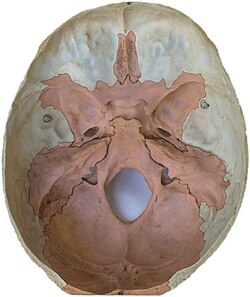Endocranium
| Endocranium | |
|---|---|

Human endocranium (pink fields), inner surface.
|
|
| Details | |
| Latin | Endocranium |
|
Anatomical terms of bone
[]
|
|
The endocranium in comparative anatomy is a part of the skull base in vertebrates and it represents the basal, inner part of the cranium. The term is also applied to the outer layer of the dura mater in human anatomy.
Structurally, the endocranium consists of a boxlike shape, open at the top. The posterior margin exhibit the foramen magnum, an opening for the spinal cord. The floor of the endocranium has several paired openings for the cranial nerves, and the anterior margin holds a spongy construction, allowing for the external nasal nerves to pass through. All bones of the structure derive from the cranial neural crest during fetal development.
In humans and other mammals, the endocranium forms during fetal development as a cartilaginous neurocranium, that ossifies from several centers. Several of these bones merge, and in the adult primates (including humans), the endocranium is composed of only five bony elements (from front to back):
The endocranium in mammals is much reduced in relative size and number of bones compared to the condition in the ancestral land vertebrates, though the occipital bone occur as several bony elements in several mammal groups. The occipital bone is also found as several bony elements in birds and reptiles, while the skull of modern amphibians is generally reduced with a simplified endocranium. The skull of early labyrinthodonts were rather complex, and contained in addition to the bones mentioned above several small cartilagious components that are fused to temporal and occipital bones in mammals:
...
Wikipedia
